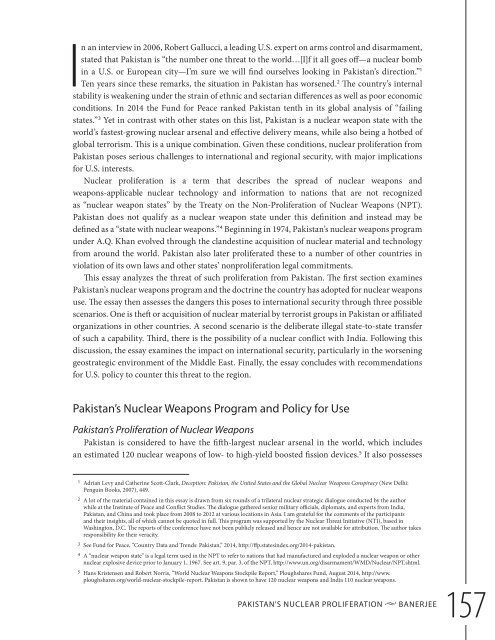pakistan’s
SR55_Mapping_Pakistan_February2016
SR55_Mapping_Pakistan_February2016
Create successful ePaper yourself
Turn your PDF publications into a flip-book with our unique Google optimized e-Paper software.
In an interview in 2006, Robert Gallucci, a leading U.S. expert on arms control and disarmament,<br />
stated that Pakistan is “the number one threat to the world…[I]f it all goes off—a nuclear bomb<br />
in a U.S. or European city—I’m sure we will find ourselves looking in Pakistan’s direction.” 1<br />
Ten years since these remarks, the situation in Pakistan has worsened. 2 The country’s internal<br />
stability is weakening under the strain of ethnic and sectarian differences as well as poor economic<br />
conditions. In 2014 the Fund for Peace ranked Pakistan tenth in its global analysis of “failing<br />
states.” 3 Yet in contrast with other states on this list, Pakistan is a nuclear weapon state with the<br />
world’s fastest-growing nuclear arsenal and effective delivery means, while also being a hotbed of<br />
global terrorism. This is a unique combination. Given these conditions, nuclear proliferation from<br />
Pakistan poses serious challenges to international and regional security, with major implications<br />
for U.S. interests.<br />
Nuclear proliferation is a term that describes the spread of nuclear weapons and<br />
weapons-applicable nuclear technology and information to nations that are not recognized<br />
as “nuclear weapon states” by the Treaty on the Non-Proliferation of Nuclear Weapons (NPT).<br />
Pakistan does not qualify as a nuclear weapon state under this definition and instead may be<br />
defined as a “state with nuclear weapons.” 4 Beginning in 1974, Pakistan’s nuclear weapons program<br />
under A.Q. Khan evolved through the clandestine acquisition of nuclear material and technology<br />
from around the world. Pakistan also later proliferated these to a number of other countries in<br />
violation of its own laws and other states’ nonproliferation legal commitments.<br />
This essay analyzes the threat of such proliferation from Pakistan. The first section examines<br />
Pakistan’s nuclear weapons program and the doctrine the country has adopted for nuclear weapons<br />
use. The essay then assesses the dangers this poses to international security through three possible<br />
scenarios. One is thet or acquisition of nuclear material by terrorist groups in Pakistan or affiliated<br />
organizations in other countries. A second scenario is the deliberate illegal state-to-state transfer<br />
of such a capability. Third, there is the possibility of a nuclear conflict with India. Following this<br />
discussion, the essay examines the impact on international security, particularly in the worsening<br />
geostrategic environment of the Middle East. Finally, the essay concludes with recommendations<br />
for U.S. policy to counter this threat to the region.<br />
Pakistan’s Nuclear Weapons Program and Policy for Use<br />
Pakistan’s Proliferation of Nuclear Weapons<br />
Pakistan is considered to have the fith-largest nuclear arsenal in the world, which includes<br />
an estimated 120 nuclear weapons of low- to high-yield boosted fission devices. 5 It also possesses<br />
1 Adrian Levy and Catherine Scott-Clark, Deception: Pakistan, the United States and the Global Nuclear Weapons Conspiracy (New Delhi:<br />
Penguin Books, 2007), 449.<br />
2 A lot of the material contained in this essay is drawn from six rounds of a trilateral nuclear strategic dialogue conducted by the author<br />
while at the Institute of Peace and Conflict Studies. The dialogue gathered senior military officials, diplomats, and experts from India,<br />
Pakistan, and China and took place from 2008 to 2012 at various locations in Asia. I am grateful for the comments of the participants<br />
and their insights, all of which cannot be quoted in full. This program was supported by the Nuclear Threat Initiative (NTI), based in<br />
Washington, D.C. The reports of the conference have not been publicly released and hence are not available for attribution. The author takes<br />
responsibility for their veracity.<br />
3 See Fund for Peace, “Country Data and Trends: Pakistan,” 2014, http://ffp.statesindex.org/2014-pakistan.<br />
4 A “nuclear weapon state” is a legal term used in the NPT to refer to nations that had manufactured and exploded a nuclear weapon or other<br />
nuclear explosive device prior to January 1, 1967. See art. 9, par. 3, of the NPT, http://www.un.org/disarmament/WMD/Nuclear/NPT.shtml.<br />
5 Hans Kristensen and Robert Norris, “World Nuclear Weapons Stockpile Report,” Ploughshares Fund, August 2014, http://www.<br />
ploughshares.org/world-nuclear-stockpile-report. Pakistan is shown to have 120 nuclear weapons and India 110 nuclear weapons.<br />
PAKISTAN’S NUCLEAR PROLIFERATION u BANERJEE<br />
157


